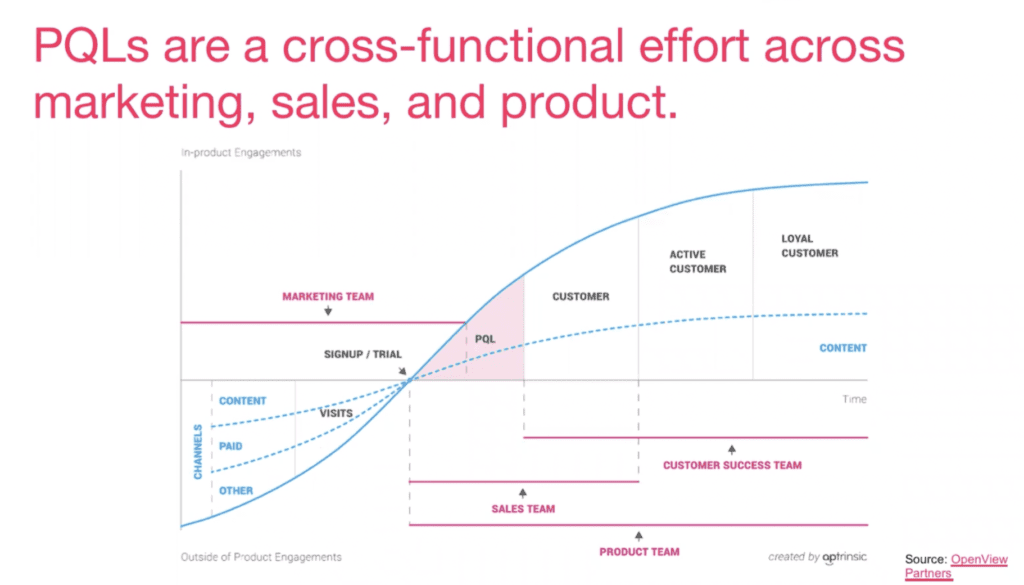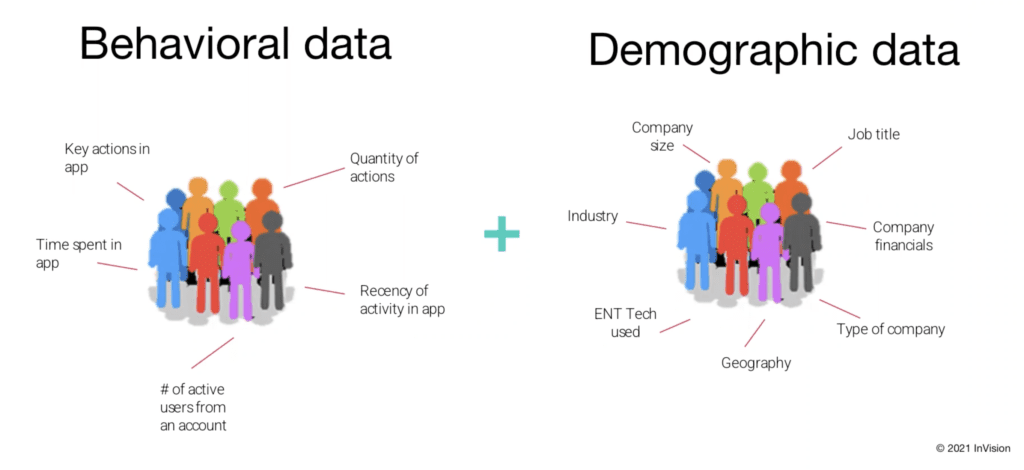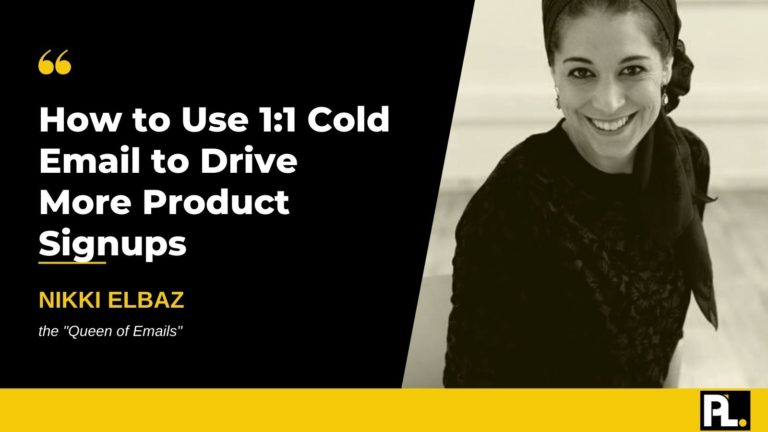Here at InVision, we’ve had a lot of experience in a product-led growth model. We started in 2011, and at the time we had a free product. But we’ve grown–to multiple products and serving enterprise solutions. We've learned what it takes to enable a product-led growth motion, and how to surface leads from our product to the sales team.
This article will teach you how to build a product-qualified lead model (PQL) to drive product-led growth, based on our experience. This method applies to companies starting fresh or existing companies that are jumping on the product-led growth bandwagon.
In this article, you’ll learn:
- Why PQL's Convert More
- What Makes a Successful PQL Model?
- Six Steps to Build a PQL Marketing Model
- How to tie it all together
Let’s get right in.
Why PQL’s Convert More
Did you know that 98% of your marketing qualified leads (MQL’s) will never result in closed sales?
Why is that?
Here’s how MQLs can miss out on valuable product leads:

The arrow going up on the left represents the marketing behavioral score; it measures when someone is ready for the MQL threshold. The threshold base represents data such as the number of site visits, content downloads, etc.
The bottom arrow that moves to the right depicts a user’s series of actions that never quite hit the MQL threshold. For example, say the user is performing meaningful action on your site, but not enough to get sales.
So what’s the solution?
PQLs!
How exactly can PQLs solve this? According to Wes Bush, author of Product Led Growth, a PQL is essentially someone:
“Who has experienced meaningful value in your product, usually through a free trial or a freemium model.”
Meaningful value can mean many different things, but essentially it's something that’s a good indicator of whether a user is ready to convert.
What Makes a Successful PQL Model?
There are three key components to a successful PQL model.
#1. Leadership Alignment
The leaders across product, marketing, and sales all need to be aligned on the KPIs for the project.
For example, what they can expect and timelines will help ensure the appropriate allocation of resources for your project.
Leadership alignment will prevent you from being bogged down by moving timelines or lack of resources.
#2. Product Team Buy-In
It may seem obvious since we're talking about a product-led growth model. But product team buy-in can be overlooked. You might involve them initially, but it might phase out.
Find the person on the product team who you can check in with as needed to ensure the team is continuously aligning to your goal.
PQLs are something everyone get’s excited about at first, but then if KPI drops in a quarter or the next–it can fall off their radar. Things change quickly when working with these models, so be sure to update your teams regularly (especially your product team) to keep everyone in the feedback loop.
#3. Time
Time is crucial to the success of a PQL model as it encapsulates your model’s beginning, middle, and end.
- The beginning: you need data to build your model, and that takes time. For example, if your end goal is to get enterprise deals, most companies will usually require around 100 closed deals to develop a model.
- The middle: you’ve rolled out the model, and are gauging if it works. For example, if your sales cycle is 3-4 months, you will need more than a month to determine if it’s working or not. Closed deals are the best way to monitor the success of a PQL model.
- The end: you’ve collected data, and you now know if something works or doesn’t work. Suppose it doesn’t work, then move on to the next model to see what does.
All three phases require time to ensure you have reliable data, so be sure to build in time buffers and that your leaders have a realistic time frame. If you don’t rush it, the data will always be more solid.
Before You Start
PQLs are a cross-functional effort. To develop a successful model, you need cross-collaboration across teams.
The graph below shows the intersection of PQLs through different teams. For example, the graph shows where the marketing, sales, and product team are, and how they all touch the PQL motion.

While it seems like a lot of work–and the collaboration may feel daunting–don’t worry, we’ve provided a starting point.
Six Steps to Build a PQL Marketing Model
With this straightforward framework, you will learn how to track, manage, and collate quality data to form your model.
#1. Ensure you have a way to track product behavior
To determine if a user’s action is meaningful, you need a way to track meaningful events.
For example, if you have an onboarding program with five different steps, the event shouldn’t merely define that the user is onboarded.
Instead, list out each of the five steps to determine which one is causing users to abandon the process. This will help you identify what’s meaningful and perhaps even fuel actions such as abandoned cart emails.
Use tools like Segment, Amplitude, Mixpanel to track events in the product, or you could even develop an internal solution.
The bottom line is to make sure it’s getting tracked.
#2. Create a game plan for analyzing your data
There are many different options to analyze data for a PQL model, and it's helpful to make a game plan to determine what you want to look at.
Here are three questions to consider when analyzing the data.
- Does your company have multiple products?
Think about how these products interact and whether you should pull multiple data sources from each product or if you want to stick to just one product.
- Do different personas have different paths to upgrade?
Consider the persona in the actual role in the product. For example, maybe the admin has a different path in meaningful events than a collaborator would.
To distinguish the paths to upgrade per persona, try using multiple models to see which path to onboarding is most direct for each one.
While it’s easier to start with one model expanding to multiple models, depending on the user’s persona, can help optimize onboarding.
- Is there a business logic that should be applied to your model?
While this may seem like a no-brainer, business logic tends to go unnoticed until after you deploy the model. Which is a disappointing time to learn users are ineligible.
For example, you’re scoring all current users, but if there’s no potential for upsell, there’s no reason to score them.
So the model shouldn’t include those current users.
Still seem a bit fuzzy? Let’s dig a bit deeper.
Consider both behavioral and demographic data with your model.

On the left is behavioral data, which represents the product data for key in-app actions such as:
- The number of actions
- The recency
- The number of users
- Active users from an account
With product-led growth, it’s essential to get many users using the product before they're ready to go to enterprise. So gauging the number of active users from a company is a really important metric.
On the right side is demographic data. Pairing demographic data with product data is essential in determining if someone with the capacity to convert performs meaningful actions.
For example, a user may have meaningful actions, but they are freelancers. So they’ll never need an enterprise plan.
#3. Analyze data & create the model.
There are two pathways when creating a model: internal or external.
The pros of internal teams are they understand the internal context, and you can work directly with them when needed. But this option could be tricky as data teams are usually strapped for resources.
If you do want to go internal, start the conversation early and align work over the company’s road map for the next six months to ensure your plan can fit into their plan.
The pros of external teams are that they’re usually quicker. Companies like Madkudu use predictive AI to tell which behaviors correlate the most to upgrading. Typical external vendors have a lot of experience building models with customers, and they can provide insight into what has and has not worked. (You can find a list of potential vendors here.)
If you decide to go external, be sure the business logic piece is communicated. The company must understand how your product works and who your eligible users are. So when they develop the model, they know which inputs to use, and they aren’t scoring ineligible users.
#4. Test, test, and test again
While this is always an essential component with marketing ops, it’s even more crucial in PQL models because of the cross-collaboration between teams.
The first question to ask the product manager is, “what do you think are the meaningful actions?”
Many times the product team might already have actions they count as meaningful that are more correlated to someone being sticky in the product, and that might not be the same as actions that are meaningful to someone converting.
Gauge what they think is meaningful and once you have the model, use that to validate a match.
Creating a pilot program to test the conversion rate is important. While this is common with MQL models, it’s just as crucial with PQL models.
Bring in your sales team and see if they have an opinion on whether the PQLs are working. Or put together a few pilot groups of sales teams and start sending PQLs to see how they convert.
Try testing different messaging to ensure the message isn’t the variable for conversion. Test a lot and create a tight feedback loop so you can respond to your findings promptly.
Use some mediums to keep track of your findings.
For example:
- Use a Slack channel to see the progress and collate data.
- Second, build fields in Salesforce to allow your team to give feedback on leads as they process them.
- Finally, build-in checkpoints to prompt continuous review of the model.
If you're working with an external company, they'll usually build that into the contract where they review the model at least once a month.
If you're working internally, build in a monthly review (or more depending on your cadence) to ensure you and the data team are aligned.
Or even better, have your team build a dashboard so you can review the model as needed.
#5. Over Communicate
Over communicating is the golden rule for the remote world, and it’s vital for building any cross-collaborated project.
To start, create a strong communication plan and a brief that includes:
- The roll-out plan
- Testing methodology
- The feedback loop plan
- Shared goals
Executing a well-thought-out plan creates trust and helps people feel more invested in what they’re doing because it feels more meaningful.
Remember, marketing, sales, and product teams all need to be aligned with the shared goal to make the magic happen.
#6. Create a clear feedback loop
Two points of validation that you should continually be looking for are:
1. The Model Validation
Is your model still working? People will often launch a new model and build in a check-in every week that lasts for the first few months and then it falls off the radar.
With a PQL model, you need to continuously check that it’s working. In an instance, things can change like:
- Customer type
- Meaningful events
If you're using an external partner, they probably have check-ins built into the product. If they have check-ins, ask them to share them with you.
If you're monitoring internally, get on the data team's roadmap!
Ideally, you should have a regularly scheduled update where you can review the results. Or set up a dashboard to review the results as needed.
2. The Sales Validation Piece
Continuously check if PQLs are helpful to sales by using a Slack channel to post feedback. Use different fields so that sales can report on the quality of the lead or differences they noticed in certain PQL’s.
Looking at both conversion rates and feedback from the sales team will help you build the data needed to show if it’s working or not.
Make sure that onboarding documents for new sales team members include any PQL projects, along with who’s in charge and how to provide feedback.
Now it’s time to tie it all together:
- Roll-out plan
- Communication plan
- Data testing plan
These are all heavy pieces of content, so to get started, develop a project outline by asking yourself:
- What do I need to create?
- How long will it take?
- What teams need to be involved?
The suggested outline provides a jumping-off point rather than just getting right to the roll-out plan without first thinking about the qualitative inputs.
In turn, this can help attract leadership buy-in and understanding if it's going to work for all of the teams' roadmaps for the next quarter or next six months.
Then identify an executive sponsor.
Executive sponsors are extremely helpful for any type of cross-collaborative project because if it's one team working on it, it's pretty easy to get everyone on board. Having an executive sponsor will also help you get on everyone’s radar, which in turn will get you on everyone’s schedule, which is crucial when cross-collaborating.
How to tie it all together
PQLs allow your product to drive the sales strategy across the board. While marketing teams will most likely try to start with product-sign-up goals. Remember, you want people that already know the product and have experienced its value. The product drives the strategy, and when sales see how much easier it is, they’ll jump on board.
Each step in the six-step framework has additional steps. So, while it may seem initially daunting, sit down and make an outline. Usually, the method will show the execution path.
And finally, don’t forget to build in all those cross-functional pieces into your model. Communicate to management that you need buy-in from all the different teams and that cross-collaboration is critical to the model’s success.









